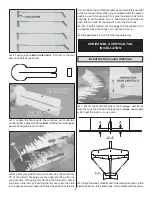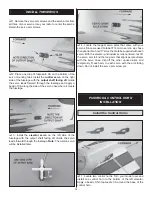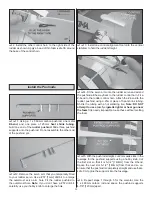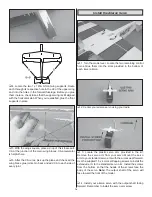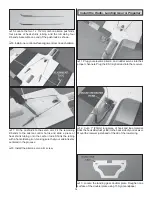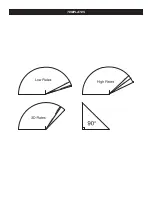
21
Takeoff
The Pluma 3D ARF can take off from the ground (ROG)
or can be hand launched. Rise-off-ground (ROG) takeoffs
should be reserved for indoor fl ying and should be performed
with the model rolling away from you and others. For your
fi rst fl ight it’s probably a good idea to have an assistant hand-
launch the plane for you. You should be ready to correct (or fl y
through) any trim errors. First, set your transmitter for LOW
RATES. Launch your plane directly into the wind (and away
from others). After your assistant launches the plane, have
him come back and adjust the trim on your transmitter. If
you want to perform an ROG takeoff, make sure the surface
you’re using is completely smooth and free from “potholes”
that can fl ip the plane or break the landing gear.
Flight
When you’re airborne and your plane is trimmed out,
throttle back and fl y the pattern. Get used to the way the
model handles with standard control inputs. When you’re
comfortable, try switching to HIGH rates to see how you
like the plane (save 3D rates for later fl ights). Based on your
preference, you may want to adjust your rates or exponential
settings in your radio. If your assistant is still available, have
him take notes for you so you can make adjustments when
you land. Fly around for a bit and try a few simple maneuvers
like: slow fl ight, gentle rolls, loops, stalls, and hammerhead
stalls. Practice a few landing approaches.
Landing
Before you land, throttle down completely (with a safe
amount of altitude). You’ll notice that when you power off,
the airplane will lose speed very quickly but will not pitch
down. To keep your speed up you’ll have to pitch down rather
steeply and this can be less than ideal for most landings. Set
up for landing by throttling down to an “idle” instead. If you
fi nd it diffi cult to get the right setting, power-off completely
and try blipping the throttle. For a short approach, power-off
completely while at altitude and pitch down. At the fl are, be
ready to blip the throttle for a gentle 3-point landing.
One fi nal note about fl ying your model: Have a goal or fl ight
plan in mind for every fl ight. This can be learning a new
maneuver(s), improving a maneuver(s) you already know,
or learning how the model behaves in certain conditions
(such as on high or low rates). This is not necessarily to
improve your skills (though it is never a bad idea!), but more
importantly so you do not surprise yourself by impulsively
attempting a maneuver and suddenly fi nding that you’ve
run out of time, altitude or airspeed. Every maneuver should
be deliberate, not impulsive. A fl ight plan greatly reduces
the chances of crashing your model just because of poor
planning and impulsive moves. Remember to think.
Have a ball! But always stay in control and
fl y in a safe manner.
GOOD LUCK AND GREAT FLYING!
Make a copy of this identifi cation tag and put it on or
inside your model.
OTHER ITEMS AVAILABLE
FROM GREAT PLANES
ElectriFly
™
RimFire
™
28-22-1380kV Out-Runner
Brushless Motor
Designed for explosive acceleration and maximum torque,
RimFire out-runner brushless motors are dependable and
virtually maintenance-free – there are not comms or brushes
to worry about, and the bearings are double-shielded. The
lightened aluminum can houses high-torque, “rare earth”
Neodymium magnet. Improved cooling means 50% more
power than other out-runners of similar size. GPMA4505
ElectriFly RimFire 28-26-1000kV Out-runner
Brushless Motor
Powered by rare-earth Neodymium magnets, RimFire out-
runner motors produce strong acceleration in planes ranging
from park fl yers to 1.60-size giants! Their high-torque design
Summary of Contents for Pluma
Page 23: ...23...
Page 24: ...TEMPLATES TEMPLATES...


